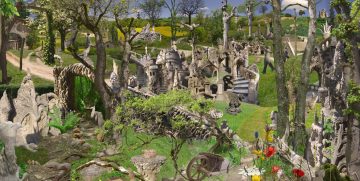Timothy SHEPARD
Timothy Shepard is an American artist who graduated from Georgetown University in Washington DC (USA). He is a double major in Fine Arts and Theology. From 1993 to 2007 he was an assistant to and mentor of Michael Kidner. He was then a visiting tutor at Central St Martins College of art and a visiting lecturer at the Royal College of Art in London (England). His work is based on the manipulation of paper, photography, montage, film and music. He produces series of works such as his “observations”, which are the result of shooting a fixed point at regular intervals, questioning the phenomena of light, in the manner of Monet’s Haystack series. He also makes collages, which he sees as a metaphor for memory, perception and consciousness. In dense landscapes, he brings together several perspectives that may recall Chinese “shan-shui- Hua” painting, in which multi-perspective and temporality are important characteristics.
Timothy Shepard created the album covers for Kevin Ayers’ The Underground in 2007 and Paul Weller’s 22 Dreams in 2008. He has exhibited at the Grosvenor Street Art Place in London (UK) and at the Center for Atmospheric Research in Boulder (USA) in 2013. His work has also been shown in galleries and at art fairs in England. In private collections, his work is also appreciated in the United States, the United Kingdom, Japan, France and Germany.
Hommage au Facteur Cheval 2009
Hommage au Facteur Cheval is a photomontage of elements that make up the Palais, and of landscapes in the Drôme countryside that recall the famous postman’s walking tours. The composition is denser in the centre, attracting attention at first glance, before revealing a wealth of details. In a verdant landscape: the staircases, the modelled palm trees and aloes, the figures, the crescent of the mosque, the tree of life and the snake in the foreground are all typical of the wonderful work of the Postman Cheval. While a dog made of assembled stones hides behind a tree, the stumbling block that triggered the construction of the postman’s dream stands beside a fern. It’s as if architecture has always been there to surprise us on our walk. Perhaps it was the vision of the Postman Cheval; didn’t he think of his palace during his long postal tours of the Drôme countryside? Note that he is absent from the composition, even though his saucepan is on the table in the foreground. Presented in the Ideal Palace, this same pot was used by the architect to make his lime mortar mixes. As a reminder of his hard work, the wheelbarrow he used to collect the countless stones for his building also stands in front of the ensemble.

